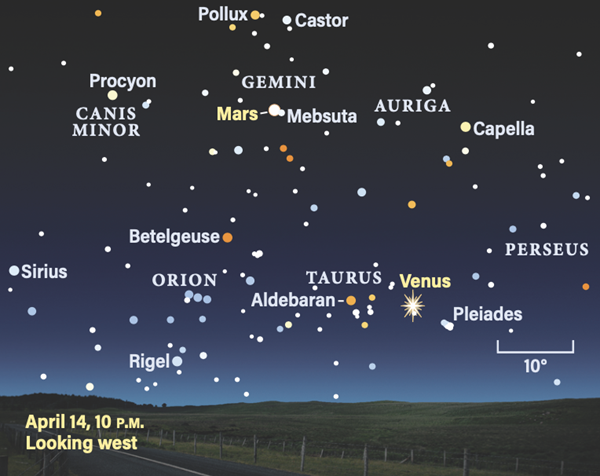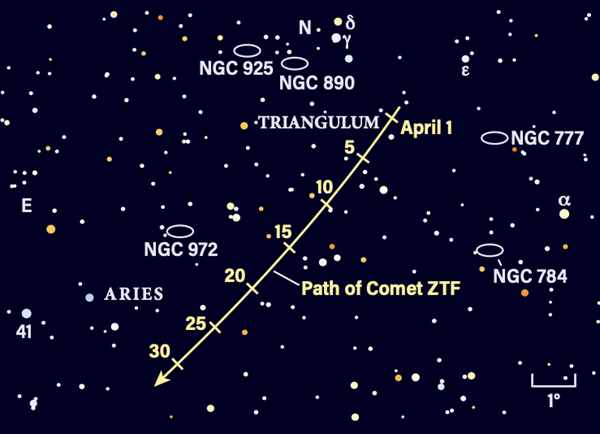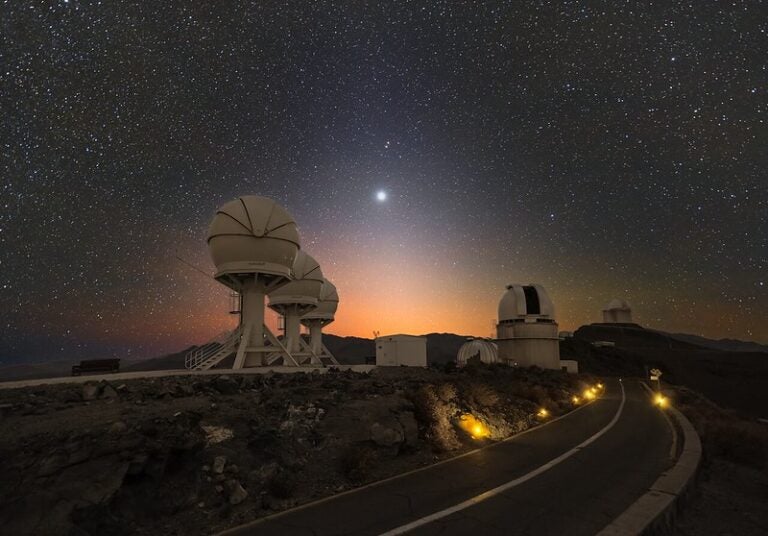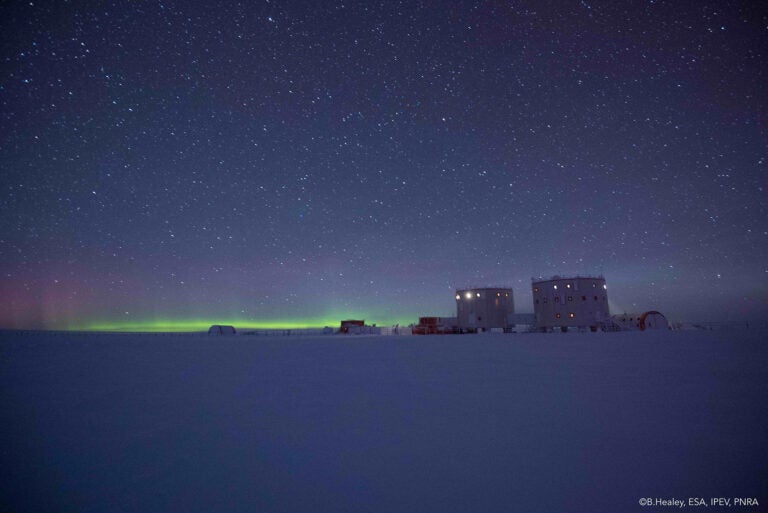
Friday, April 14
Mars has a close encounter with the star Mebsuta in Gemini the Twins tonight. Although it won’t pass in front of the star from our point of view (called an occultation), it will come within about ¼° of the star for a stunning sight.
About an hour after sunset, the two are still more than 50° above the western horizon. Venus, which hangs to their lower right, will appear as the brightest object in the region, sitting to the upper left of the Pleiades in Taurus. Mars and Mebsuta sit below the two bright stars that mark Gemini’s heads: Pollux to the left and Castor to the right.
Mebsuta, which is about 13° below Castor, shines at magnitude 3.1; Mars is two magnitudes brighter, at 1.1. Through a telescope, the Red Planet appears just 6″ across; it now sits some 148 million miles (239 million kilometers) from Earth after making its closest approach to our planet late last year.
For another close pair to observe, swing your telescope back up to Castor: This is a beautiful binary star on a centuries-long orbit that are currently pulling apart. They now sport more than 6″ between them. And if you look just over an arcminute to the south, you’ll land on a third, 10th-magnitude star that orbits the main pair. Each of these three stars is itself a double, making Castor a six-star system in total.
Sunrise: 6:24 A.M.
Sunset: 7:38 P.M.
Moonrise: 3:42 A.M.
Moonset: 1:17 P.M.
Moon Phase: Waning crescent (35%)
*Times for sunrise, sunset, moonrise, and moonset are given in local time from 40° N 90° W. The Moon’s illumination is given at 12 P.M. local time from the same location.

Saturday, April 15
Shortly after sunset tonight, try to catch Comet C/2020 V2 (ZTF) as it flies near the galaxy NGC 972 in Aries. You’ll want to be set up and ready to go about an hour after sunset, when Aries is low in the northwest. Comet ZTF is about 9° high and stands about 5° south-southeast of 4th-magnitude Gamma (γ) Trianguli in Triangulum.
You’ll want to opt for a larger scope (8 inches or more) from the darkest site possible to search for them visually. The comet has recently been spotted at around 10th magnitude — slightly brighter than nearby NGC 972 at magnitude 11. The two are now 2.5° apart, with NGC 972 to the comet’s east. Compare their brightness and shape in your telescope — both will look like softly glowing fuzzballs.
ZTF will continue to slide southeast through the field over the next few days, coming closest to NGC 972 around the 20th. However, the region will continue to set slightly earlier each day, meaning you’ll have less time to enjoy the view.
The Moon reaches perigee, the closest point to Earth in its orbit, at 10:24 P.M. EDT. At that time, our satellite will sit 228,645 miles (367,968 km) away. Shortly after, Luna passes 3° south of Saturn at midnight EDT. We’ll catch up with the pair tomorrow in the early-morning sky.
Sunrise: 6:22 A.M.
Sunset: 7:39 P.M.
Moonrise: 4:18 A.M.
Moonset: 2:33 P.M.
Moon Phase: Waning crescent (24%)
Sunday, April 16
An hour before sunrise, the waning crescent Moon hangs below the planet Saturn in the east. Both are in Aquarius the Water-bearer, whose stars are rising ahead of the Sun.
Turn a telescope on the Moon first to view its still-lit western edge. Can you make out the distinct dark oval of the crater Grimaldi or the bright, rayed Byrgius to its south? Most of the lunar surface is experiencing darkness, but you might see some of its face faintly illuminated by earthshine — sunlight bouncing off Earth and lighting up the shadowed regions of the Moon.
Next, move to the Moon’s upper right to center on Saturn. The gas giant’s disk stretches 16″ across, with its rings spanning more than twice that distance. Those rings are now tilted toward us at a shallow angle of about 8°; in a few years’ time, they will appear edge-on. Saturn’s largest and brightest moon, Titan, lies nearly 2′ to the planet’s northwest — can you spot it? Most of Saturn’s other moons are fainter and much closer to the rings, and may not be visible in the growing twilight.
Sunrise: 6:21 A.M.
Sunset: 7:40 P.M.
Moonrise: 4:49 A.M.
Moonset: 3:49 P.M.
Moon Phase: Waning crescent (15%)
Monday, April 17
Making its way across the sky, the waning Moon passes 2° south of Neptune at 1 P.M. EDT. The distant ice giant is just starting to reappear from behind the Sun, but intrepid early risers can try to catch the pair this morning — though it will be a challenge.
The Moon is just 10 percent lit as it wanes toward New in a few days. The thin crescent stands some 5° high in the east 30 minutes before sunrise. Neptune lies 5.5° to Luna’s upper left (northeast), but at magnitude 7.8, you’ll need binoculars or a telescope to find it. This won’t be overly easy in the brightening sky, so the earlier you can start searching, the better. Try about 45 minutes ahead of sunrise — though note that sunrise from your particular location may differ from the time listed below. Always make sure to put away any binoculars or telescopes well ahead of the time the Sun will rise above the horizon.
If you’re having trouble finding Neptune, you can instead swing your gaze up toward Saturn again. The ringed planet stands 15° high in the southeast 30 minutes before sunrise this morning. At magnitude 0.9, it is much easier to catch in your sights, with Titan now northwest of the planet. At this time tomorrow morning, Titan will sit north of the pole as it moves along its orbit.
Sunrise: 6:19 A.M.
Sunset: 7:41 P.M.
Moonrise: 5:16 A.M.
Moonset: 5:02 P.M.
Moon Phase: Waning crescent (8%)

Tuesday, April 18
Our target for tonight lies in Camelopardalis, a circumpolar constellation that swings around the North Star as Earth turns on its axis. About two hours after sunset, look north to find Polaris. From there, look to the left and just slightly up to locate the bright star Capella about 43.5° away. Roughly halfway between these two stars lies 4th-magnitude Alpha (α) Camelopardalis.
With binoculars or a small scope, look about 7° southwest of this star. You’ll land smack dab in the middle of a line of just over a dozen stars running northwest to southeast and about 2.5° long. Most of the stars are between magnitude 7 and 9, but about halfway through is a bright 5th-magnitude sun.
This line is called Kemble’s Cascade after Father Lucian Kemble, who discovered it. It is so named because the line of stars appears to “cascade” southeastward, ending in the small open cluster NGC 1502, whose fuzziness evokes the spray thrown up by a waterfall as it tumbles into a pool.
Sunrise: 6:18 A.M.
Sunset: 7:42 P.M.
Moonrise: 5:41 A.M.
Moonset: 6:14 P.M.
Moon Phase: Waning crescent (3%)
Wednesday, April 19
The Lyrid meteor shower is set to peak in just a few short days. With no Moon in the morning sky, it’s the perfect chance to try spotting meteors as the shower begins to ramp up. The best time to step outside is in the few hours before sunrise, when the Lyre is high in the eastern sky. The constellation’s brightest star, Vega, shines at magnitude 0; together with Deneb in Cygnus and Altair in Aquila, it completes the Summer Triangle asterism, which appears high overhead at night during the summer season in the Northern Hemisphere.
The Lyrids’ radiant — the point from which its meteors appear to originate — lies about 8° to the upper right (southeast) of Vega as the constellation is rising. Once you’ve found the area, look away from it to the north or south, as this is where meteors will show the longest tails. Although the shower’s peak rate isn’t expected to be particularly high, only around 20 meteors per hour, you can still expect to see a few meteors per hour in the mornings of the days leading up to that peak, which occurs the 22nd.
Sunrise: 6:16 A.M.
Sunset: 7:43 P.M.
Moonrise: 6:05 A.M.
Moonset: 7:26 P.M.
Moon Phase: New

During a total solar eclipse, the Moon completely covers the Sun’s disk. This week, a rarer hybrid solar eclipse occurs: an eclipse that is annular at the beginning and end, but total for most of its time on Earth.
NASA Goddard Space Flight Center/Romeo Durscher (Flickr)
Thursday, April 20
New Moon occurs at 12:13 A.M. EDT, setting up a rare hybrid solar eclipse that begins at sunrise and will run from the Indian Ocean up over a tiny promontory of Australia, over East Timor and West Papua, and finally end above the Pacific Ocean at sunset. It’s called a hybrid eclipse because the event appears as an annular eclipse (where the Moon doesn’t cover the edges of the solar disk) at either end, but a total solar eclipse in the middle. This occurs when the curvature of Earth causes the Moon’s shadow to fall slightly short at the endpoints of the eclipse.
On the other side of the world, we’ll put our concentration into the evening sky. Venus passes 8° north of Aldebaran at 5 P.M. EDT; shortly after sunset, the pair stand slightly closer, some 7.5° apart, with Venus slightly northeast of the star. Magnitude 0.9 Aldebaran is often envisioned as the eye of Taurus the Bull; it sits amid (but is not physically part of) the Hyades open cluster, which will begin to appear as the sky grows truly dark.
Venus, a blazing magnitude –4.1, is unmissable even in the twilight. Through a telescope, the planet’s face appears some 70 percent lit and spans 16″. Far to the planet’s upper right (north) is Capella, the magnitude 0.1 alpha star of Auriga the Charioteer. To Venus’ lower right is the Pleiades, a tightly packed young cluster of stars that sits close to Earth.
Sunrise: 6:15 A.M.
Sunset: 7:44 P.M.
Moonrise: 6:30 A.M.
Moonset: 8:37 P.M.
Moon Phase: New
Friday, April 21
The Moon passes 1.7° north of Uranus at 9 A.M. EDT, while Mercury is stationary against the background stars at noon EDT.
You can catch all three in the evening sky. About 30 minutes after sunset, the thin crescent Moon is still 15° high in the west. You can use it to find Mercury, which lies just over 8.5° west and hangs closer to the horizon, only 7° high at this time. The small planet is magnitude 1.9 and will likely require binoculars or a telescope to spot. Its disk spans 10″ and appears just 11 percent lit. Magnitude 5.9 Uranus is within 4° of Mercury (to its east-southeast) but will be even more challenging to locate. Those observing from higher altitudes under clear conditions will have the best chance of finding it in the still-bright sky.
As darkness falls and the planets sink out of sight, look for the brightest stars in the region to begin popping into sight. Aldebaran in Taurus and Betelgeuse in Orion, both red giants, will appear to the upper left of the Moon. Canis Major’s Sirius — the brightest star in the sky — sits slightly lower in the southwest, while its counterpart, Procyon in Canis Minor, is some 26° directly above it.
Sunrise: 6:13 A.M.
Sunset: 7:45 P.M.
Moonrise: 6:59 A.M.
Moonset: 9:48 P.M.
Moon Phase: Waxing crescent (3%)










